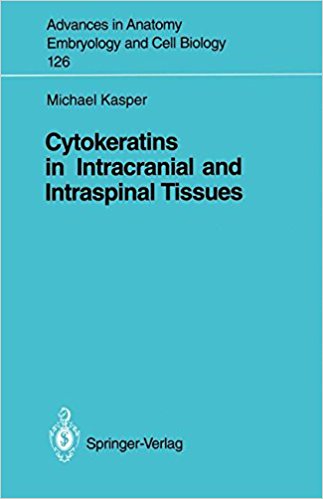

 |

|

Sold Out
Book Categories |
1. 1 The Cytokeratins as a Member of the Intermediate Filament Protein Family Intermediate filaments together with microtubules and actin microfilaments make up the filamentous cytoskeleton found in the cytoplasm of vertebrate cells. Recently, intermediate filament proteins have also been described in invertebrates, but their chemistry is not yet known (for review see Biessmann and Walter 1989). These filaments (about 10 nm in diameter) used to be categorized into five classes - cytokeratin, vimentin, desmin, glial fibrillary acidic protein (GFAP), and neurofilaments (NFs). The expression of these proteins follows differentiation-dependent rules: cytokeratins occur in epi thelial cells, NF proteins are expressed in neurons, GFAP in astrocytes and some nonglial cells, desmin in smooth muscle cells and in striated myocytes, and vimentin in mesenchymal cells (for review see Lazarides 1980; Osborn and Weber 1983). Recent investigations including deoxyribonucleic acid (DNA) and protein sequencing and peptide mapping have redefined the intermediate filaments into five types or subfamilies (type I, acidic cytokeratins; type II, basic cytokeratins; type III, vimentin, desmin, peripherin, and GFAP; type IV, the three NF proteins; and type V, the nuclear lamins (for review see Nagle 1988). A new type VI intermediate filament protein, nestin, has been described in the developing nervous system (Lendahl et al. 1990), and is initially co expressed with vimentin in neuroepithelial stem cells (Steinert and Liem 1990). The cytokeratins are the most complex subgroup of intermediate filament proteins."
Login|Complaints|Blog|Games|Digital Media|Souls|Obituary|Contact Us|FAQ
CAN'T FIND WHAT YOU'RE LOOKING FOR? CLICK HERE!!! X
 You must be logged in to add to WishlistX
 This item is in your Wish ListX
 This item is in your CollectionCytokeratins in intracranial and intraspinal tissues
X
 This Item is in Your InventoryCytokeratins in intracranial and intraspinal tissues
X
 You must be logged in to review the productsX
 X
 X

Add Cytokeratins in intracranial and intraspinal tissues, , Cytokeratins in intracranial and intraspinal tissues to the inventory that you are selling on WonderClubX
 X

Add Cytokeratins in intracranial and intraspinal tissues, , Cytokeratins in intracranial and intraspinal tissues to your collection on WonderClub |